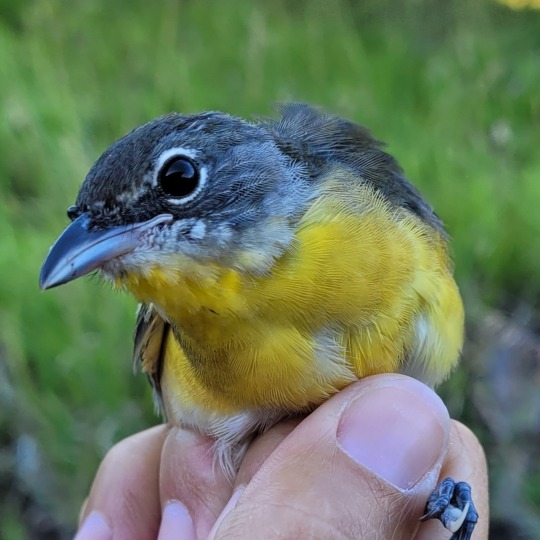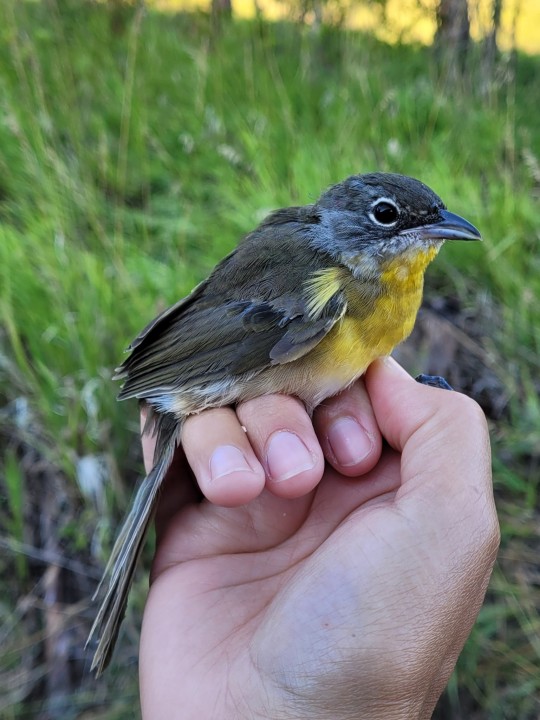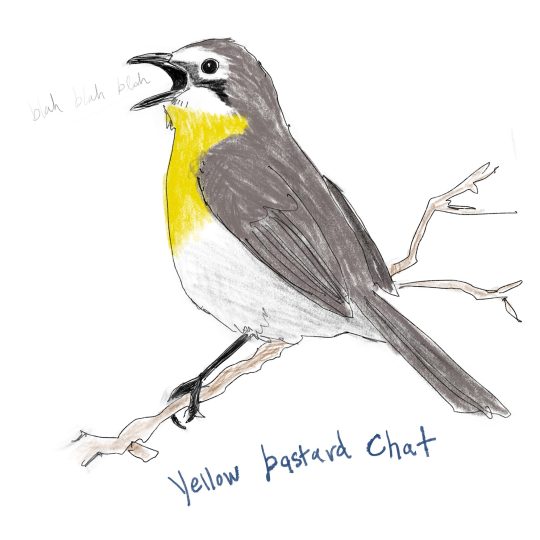#icteria
Explore tagged Tumblr posts
Text

imagine you're a chat and you ditch your chat spouse to go to the chat nightclub to have a hot chat date and you see your chat spouse there who is also ditching you. wyd
(from the Yellow-breasted Chat account in Birds of the World)
#yellow breasted chat#birds#animal behavior#icteria virens#icteria#icteriidae#passeriformes#shitpost#birding
532 notes
·
View notes
Text

Yellow-breasted Chat (Icteria virens), family Icteriidae, order Passeriformes, Uvalde, TX, USA
This species was once considered to be a wood warbler, family Parulidae, but is now placed in its own family (of which it is the only member).
Genetic studies suggest that their closest living relatives are the black birds in the family Icteridae.
photograph by Mick Thompson
343 notes
·
View notes
Text

Setophaga petechia | Vireo griseus | Icteria virens | Vireo olivaceus | Spinus tristis | Parkesia motacilla
Plate XV | Die Nordamerikanische Vogelwelt (1891)
#bird art#bird illustration#vintage art#vintage illustration#artists on tumblr#parulidae#vireonidae#icteriidae#fringillidae#setophaga petechia#yellow warbler#vireo griseus#white eyed vireo#icteria virens#yellow breasted chat#vireo olivaceus#red eyed vireo#spinus tristis#american goldfinch#parkesia motacilla#louisiana waterthrush#anton goering
11 notes
·
View notes
Text
BOTD: Yellow-breasted Chat

Photo: Mick Thompson
"A bizarre series of hoots, whistles, and clucks, coming from the briar tangles, announces the presence of the Yellow-breasted Chat. The bird is often hard to see, but sometimes it launches into the air to sing its odd song as it flies, with floppy wingbeats and dangling legs, above the thickets. This is our largest warbler, and surely the strangest as well, seeming to suggest a cross between a warbler and a mockingbird."
- Audubon Field Guide
#birds#yellow breasted chat#birds of north america#north american birds#birds of america#american birds#chat#chats#passerines#bird#bird watching#birds of the us#birds of mexico#birds of central america#birding#birdblr#birblr#Icteria virens
28 notes
·
View notes
Video
Yellow-breasted Chat ..."Buffoon of the Briar Patch"1437 crop MCSP Southern California by Pekabo Via Flickr: "The chat is a true birder’s bird. Most non-birding members of the general public have probably never even heard of this species, and few would ever find themselves in the right kind of place to stumble upon one by chance. Yellow-breasted Chats can be challenging to find even with dedicated search effort, largely owing to their preference for densely vegetated, brushy habitat with nearly impenetrable tangles. Once discovered, however, they display animated antics that have charmed many a naturalist. Their jaunty, cocked tails and prominent white spectacle markings lend them a distinctive, expressive appearance, further enhanced by the boldly contrasting plumage of the brilliant golden throat, the clean white underbelly, and the camouflaged olive-green of the upperparts. Though they are frequently skulky and silent during migration and the winter months, Yellow-breasted Chats can be shockingly conspicuous in the breeding season. Males post up on high perches, belting out chaotic, improvisational songs that feature a blend of hoots, growls, whistles, chatters, purrs, cackles, mewls, squawks, and mimicry of other species. They regularly launch into an impressive song flight, flapping dramatically with exaggerated tail pumps all while constantly vocalizing in midair. These musical performances sometimes continue long into the dark of the night, which may help passing nocturnal migrants locate suitable habitat on the ground below. With this varied repertoire of bizarre noises taken into account, the “chat” portion of the species moniker is clearly every bit as apt as “yellow-breasted” is. One of the most intriguing details about this species is the turbulent history of its taxonomic classification. For decades, Icteria virens was designated a member of the wood-warbler family Parulidae, but it was understandably considered to be an aberrant outlier. This placement never quite sat right with many birders and ornithologists, as the chat’s structure and behavior are so wildly different from anything else in the tribe. Nebulous comments in field guides and checklists that the bird “might not belong” were a gross oversimplification of more than a century of scientific disagreements about its true affinities. In-depth genetic studies of New World passerines revealed that the Yellow-breasted Chat inhabits a distinct branch of the tree of life that is sister to the family Icteridae, which includes blackbirds, orioles, meadowlarks, oropendolas, and others. Some authorities have assigned the chat to that family as well, but the American Ornithological Society presently recognizes the species as the sole representative of a monotypic family: Icteriidae. " nemesisbird.com
#Icteria virens#Yellow-breasted Chat#Reinita Grande#Ictérie polyglotte#not a warbler#new gear#canon R7#200-800#birdwatching Los Angeles#Malibu creek state park birds#might sing at night#weirdo#flickr
0 notes
Text
The medical term is icterus, from the Greek word ikteros.[63] The word icterus comes from an ancient belief that jaundice could be cured by looking at the yellow bird icteria.[64]
Worth a try
50 notes
·
View notes
Text




Yellow-breasted Chat (Icteria virens)
Chadron State Park - Fall '22 & '23
Would you believe my lifer YBCH was the first bird pictured here? In the Eastern US, Yellow-breasted Chat aren't rare, they just aren't common either. Typically migrants and very skulky, it can be hard to find one when they aren't singing their pretty head off. Once out West I had an easier time hearing them, especially since they like to cluster around water sources in the dry Southwest region.
Three different birds are pictured. All adult Yellow-breasted Chat have the same bright, lemon yellow chest they're named for, regardless of sex. The third bird pictured was a hatch-year, and still had some dingy juvenile plumage showing. The best way to tell these birds apart in hand is by the roof of their mouth! Males will be pitch-black, while females have a white-ish to pink mouth. Younger birds will be more dull, of course, but can still sometimes be sexed this way. In the field its best to get a good look at the mask and see if it is black (male) or dark gray (female)- or you could just wait until the male starts his long and loud chatter of a song.
All banding, marking, and sampling is being conducted under a federally authorized Bird Banding Permit issued by the U.S. Geological Survey's BBL. Permission to share images was granted by Bird Conservancy of the Rockies (BCR).
#yellow breasted chat#bird banding#(Not Warbler)#couldn't remember if I had posted these or not so I had to go scrounging
48 notes
·
View notes
Text
okay so I went through and tested a bunch of urls... none of the ones I was thinking of were available, oh well, so now I have to figure this out lol. I don't want to misspell/leetspeak a scientific name, so I only tried genus-species names or one or the other. here are my options!
6 notes
·
View notes
Text

Yellow-breasted Chat (Icteria virens), family Icteriidae, order Passeriformes, Uvalde, TX, USA photograph by Mick Thompson
0 notes
Text
Icteria virens

By Bettina Arrigoni, CC SA-2.0
Etymology: Yellow Bird
First Described By: Vielliot, 1808
Classification: Dinosauromorpha, Dinosauriformes, Dracohors, Dinosauria, Saurischia, Eusaurischia, Theropoda, Neotheropoda, Averostra, Tetanurae, Orionides, Avetheropoda, Coelurosauria, Tyrannoraptora, Maniraptoromorpha, Maniraptoriformes, Maniraptora, Pennaraptora, Paraves, Eumaniraptora, Averaptora, Avialae, Euavialae, Avebrevicauda, Pygostaylia, Ornithothoraces, Euornithes, Ornithuromorpha, Ornithurae, Neornithes, Neognathae, Neoaves, Inopinaves, Telluraves, Australaves, Eufalconimorphae, Psittacopasserae, Passeriformes, Eupasseres, Passeri, Euoscines, Passerides, Core Passerides, Passerida, Passerid Clade, Icteridae
Status: Extant, Least Concern
Time and Place: Within the last 10,000 years, in the Holocene of the Quaternary


The Yellow-Breasted Chat is known from all over North America

Physical Description: Yellow-Breasted Chats are medium sized perching birds, about 19 centimeters in length, with thick beaks and long tails. They have grey heads and backs, with olive wings and tails. Their breasts - as suggested by their names - are bright yellow, while their rumps are more white in color. Their heads have an interesting black stripe over the eye, flanked on either side by distinctive white stripes. Though they vary a bit in color among sub-populations, the sexes tend to be similar. The juveniles, meanwhile, have more greyish-brown colors on their heads and breasts before reaching sexual maturity.
Diet: Yellow-Breasted Chats feed primarily on insects and other invertebrates, though they supplement their diets with berries and fruits.

By Stanislav Harvančík, all rights reserved
Behavior: These birds will forage by going through the dense understory of the forest, though they do occasionally hop down to the ground to look for food. Interestingly enough, they hold their food with their feet while eating! These are shy birds, which are usually heard but never seen. They do sing, from time to time, usually a loud jumble of cackling, rattling, whistling, and even mewing. They do make a more uniform “chack chack chack” call to each other, similar in a lot of ways to the Grey Catbird.
The Yellow-Breasted Chat does migrate, sometimes over somewhat long distances - they breed in the continental United States, migrate across Northern Mexico, and then spend the winter in Southern Mexico and the rest of “central” America. Some populations do stay in Mexico their whole life, and only migrate a little between scrubland and forest habitat based on the season. Mating begins in May and extends through early August, though egg laying is concentrated in April through July. Double-brooding is very common, so they lay two broods per season. They make nests out of weed stalks, straw, leaves, and bark, which are placed low in the shrub or on a small tree. They lay between three and five eggs, which are incubated for two weeks, and then the nestlings are cared for for another week and a half or so. They guard their nests vigorously, given common parasitism - however, they are not very monogamous birds, though they do tend to stay in pairs as a general rule.

By Emily Willoughby, CC BY-SA 3.0
Ecosystem: During the breeding season, Yellow-Breasted Chats live in dense thicket and scrub on the edge of woodland; they move to more woody areas during the off season, especially pine savanna and riparian forest, as well as some mangrove forests. Their nests are typically parasitized by Cowbirds and Cuckoos.
Other: This bird is not considered threatened with extinction, as it is very common over its entire range, doesn’t show long-term changes in population, and isn’t particularly threatened with habitat loss (since it’s well-adapted for a variety of habitats). Interestingly enough, the Yellow-Breasted Chat is a very genetically distinct type of bird, and is placed in its own group separate from other songbirds.
~ By Meig Dickson
Sources under the Cut
Curson, J. & Garcia, E.F.J. (2019). Yellow-breasted Chat (Icteria virens). In: del Hoyo, J., Elliott, A., Sargatal, J., Christie, D.A. & de Juana, E. (eds.). Handbook of the Birds of the World Alive. Lynx Edicions, Barcelona.
Jobling, J. A. 2010. The Helm Dictionary of Scientific Bird Names. Christopher Helm Publishing, A&C Black Publishers Ltd, London.
Sibley, David Allen. The Sibley Field Guide to Birds of Western North America.
#Icteria#Icteria virens#Dinosaur#Songbird#Yellow-Breasted Chat#Passeriform#Songbird Saturday & Sunday#Insectivore#North America#Quaternary#Bird#Birds#Dinosaurs#Birblr#Factfile#Chat#biology#a dinosaur a day#a-dinosaur-a-day#dinosaur of the day#dinosaur-of-the-day#science#nature
51 notes
·
View notes
Photo


Yellow-breasted Chat, front and back (by me)
#Yellow-breasted Chat#Icteria virens#Icteria#Icteriidae#Passeroidea#Passerida#Passeri#Passeriformes#Psittacopasserae#Eufalconimorphae#Aves#birds#chat#autumn#Donaldson Park#Middlesex County#New Jersey#mine
3 notes
·
View notes
Photo

Yellow Bastard Chat Common Name: Yellow-breasted Chat
This obnoxious shit can never be serious. He may look pretty, but he’s a goddamned clown. He’s the kind of bird that’s always chuckling. Or gurgling. Or making various squeaks and squawks. He gets a real kick out of hiding in hedges and mimicking a crow or maybe a car horn. It’s pretty much impossible not to hate this bird as soon as he opens his fucking beak.
Color: Bright yellow and whatever. I hate this guy.
Bird Region: North America
🦅🦅🦅
Read all about this and other avian asshats from around the world in my latest book:
The Field Guide to Dumb Birds of the Whole Stupid World
#dumb birds#field guide#yellowbastardchat#dumbbirds#birddrawing#birdart#birbs#birdsofinstagram#birds of tumblr#birding#Birdwatching#importantbirds#icteria virens#humor#books#FGTDBONA#im back
94 notes
·
View notes
Note
✨I randomly saw a yellow-breasted chat when walking home today; any cool info about them?
Yellow-breasted Chat:
One of the birds I most look forward to seeing during Spring Migration. They don't breed here in SE Texas.
For a long time, ornithologists did not know how to classify them. They were grouped with the New World/Wood Warblers for a long time, even though we all knew they were most likely not warblers at all. Genetic analysis of Yellow-breasted Chats revealed that they are most closely related to the black birds in the family Icteridae, but are distant enough from all other birds to warrant their own family Icteriidae (note the similar spelling but with an extra i to be confusing).
They are not related to old world birds with the word "chat" in their common name.
Unlike their close relatives, the YB Chat is known to sometime mimic the calls of other bird species.
youtube

Yellow-breasted Chat (Icteria virens), family Icteriidae, order Passeriformes, Uvalde, TX, USA
photograph by Mick Thompson

Yellow-breasted Chat (Icteria virens), family Icteriidae, order Passeriformes, Knoxville, Tennessee, USA
This species was once considered to be a wood warbler, family Parulidae, but is now placed in its own family (of which it is the only member).
Genetic studies suggest that their closest living relatives are the black birds in the family Icteridae.
Omnivorous.
Not terribly monogamous. Though they pair off, there is much mating outside of the pair bond.
photograph by Loud Photography
103 notes
·
View notes
Photo

Yellow-breasted Chat
35 notes
·
View notes
Photo


Fall bird banding has started!
Yellow-breasted Chat (Icteria virens)
September 10, 2019
Rushton Woods Preserve, Willistown, Pennsylvania
#bird#birds#photographers on tumblr#chat#yellow breasted chat#Icteria virens#migration#bird banding#birb#birbs#birdblr#ornithology#birblr#birds on tumblr
134 notes
·
View notes
Photo

A new variant has been added!
Yellow-breasted Chat (Icteria virens) © Edwin L Sheppard
It hatches from bright, conspicuous, dense, difficult, dull, green, long, much, olive, own, slow, strange, thick, uncommon, unique, variable, white, widespread, and yellow eggs.
squawkoverflow - the ultimate bird collecting game 🥚 hatch ❤️ collect 🤝 connect
0 notes
